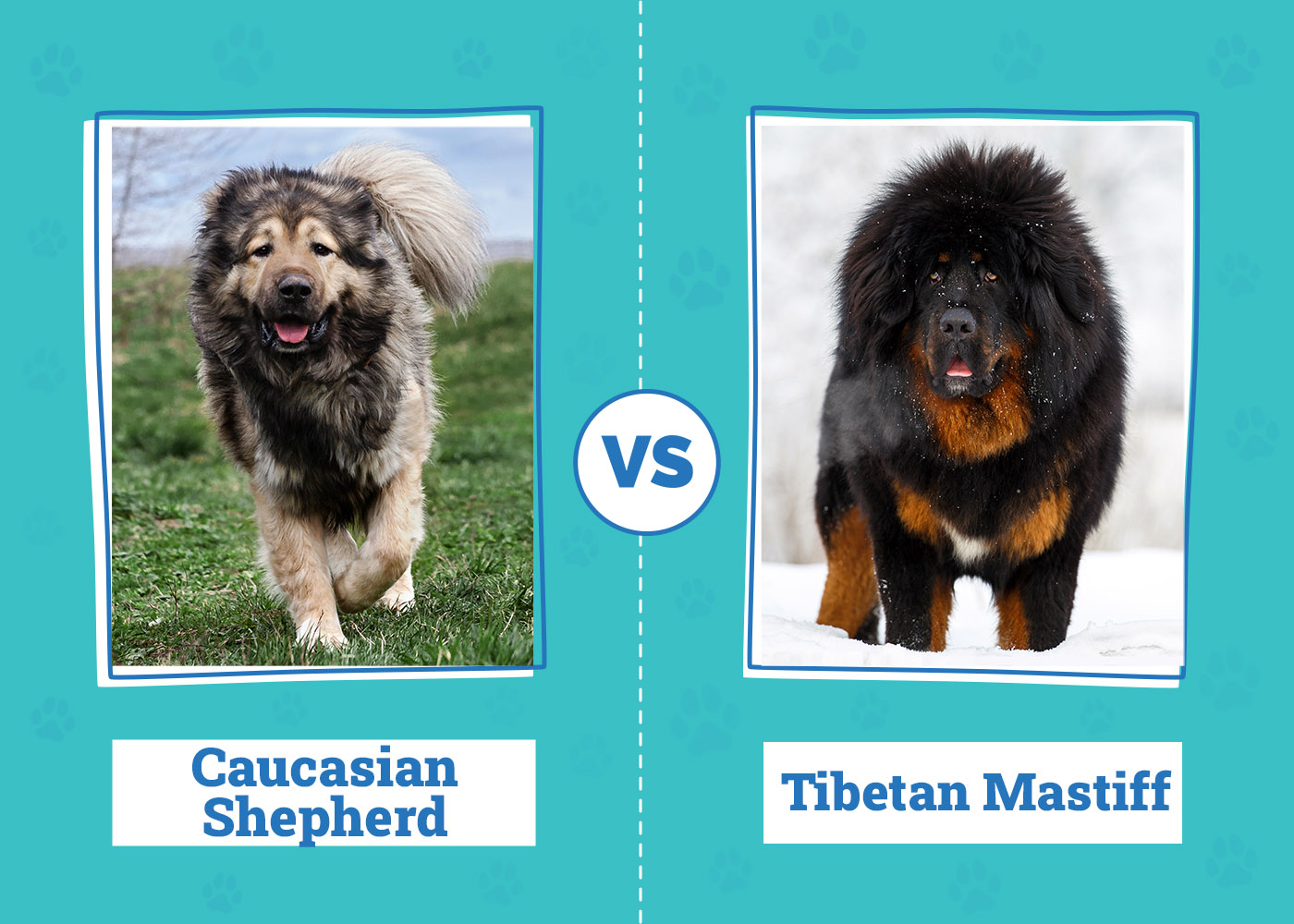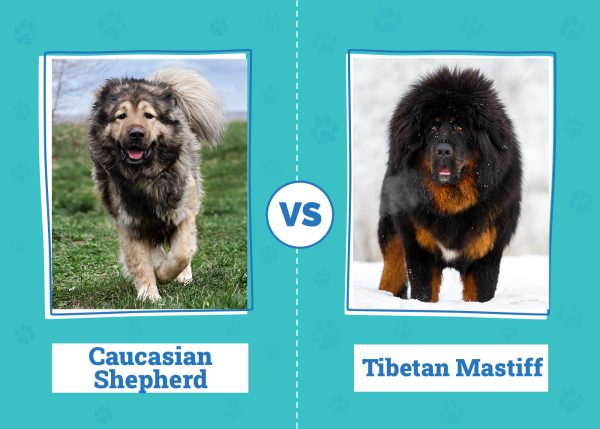Click to Skip Ahead
The Caucasian Shepherd Dog and Tibetan Mastiff are both awe-inspiring canines whose very presence commands respect. They descend from ancient dogs in the Caucasus mountains and Tibet and protecting people and property is a job that these kinds of dogs have performed diligently and fearlessly for eons.
In this post, we’ll highlight the characteristics that make the Caucasian Shepherd Dog and Tibetan Mastiff similar to and different from one another.

Visual Differences
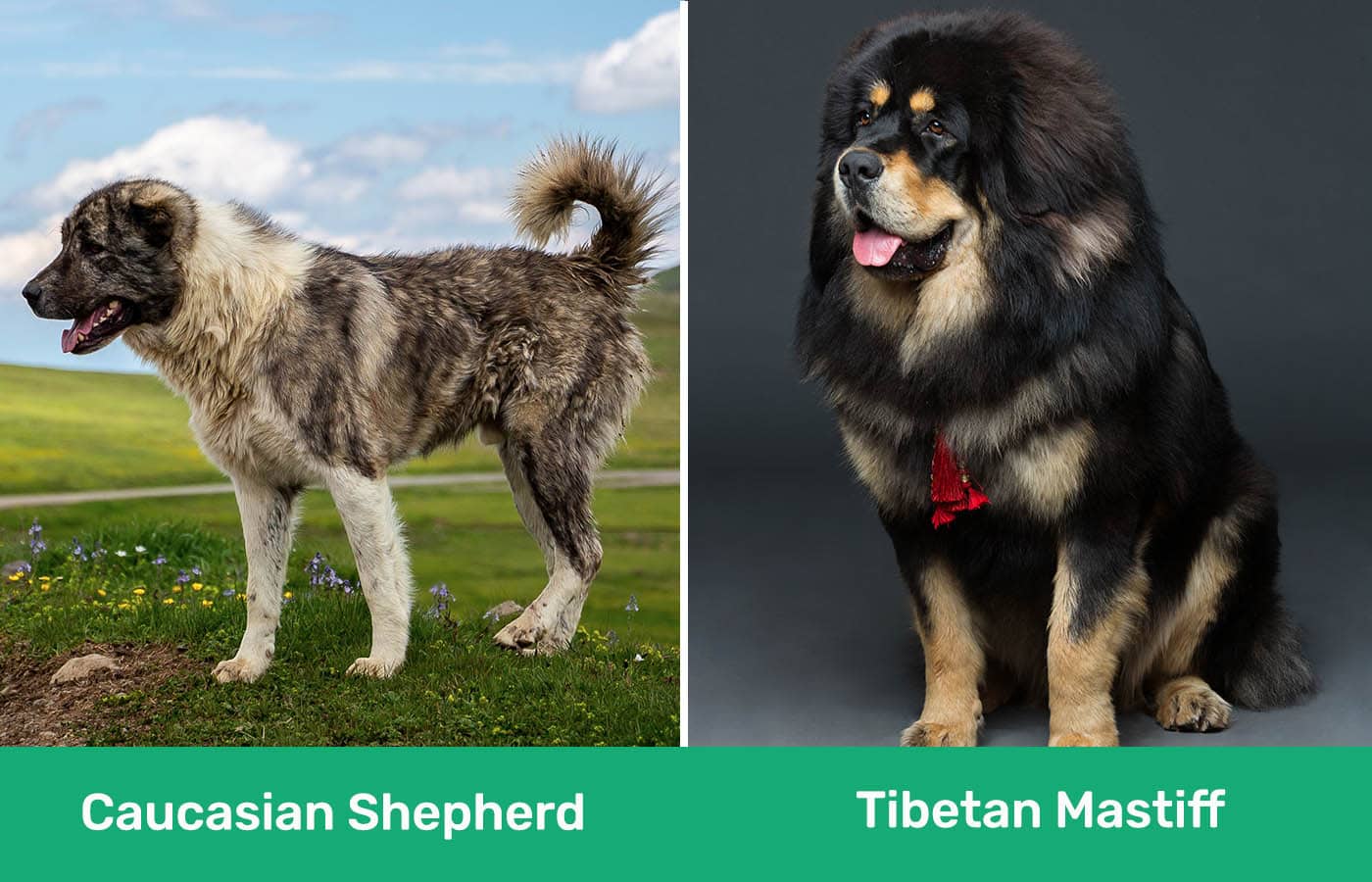
At a Glance
- Average height (adult): 23–30 inches
- Average weight (adult): 99–170 pounds
- Lifespan: 10–12 years
- Exercise: 1+ hour per day
- Grooming needs: Moderate
- Family-friendly: Yes, if socialized and trained properly
- Other pet-friendly: Sometimes, if socialized
- Trainability: Very intelligent and quick to learn, but independent and assertive
- Average height (adult): 24 inches minimum (female), 26 inches minimum (male)
- Average weight (adult): 70–150 pounds
- Lifespan: 10–12 years
- Exercise: 1+ hour per day
- Grooming needs: Moderate
- Family-friendly: Yes, with proper socialization and training
- Other pet-friendly: Sometimes, if socialized
- Trainability: Highly intelligent but can be strong-willed and independent
Caucasian Shepherd Overview
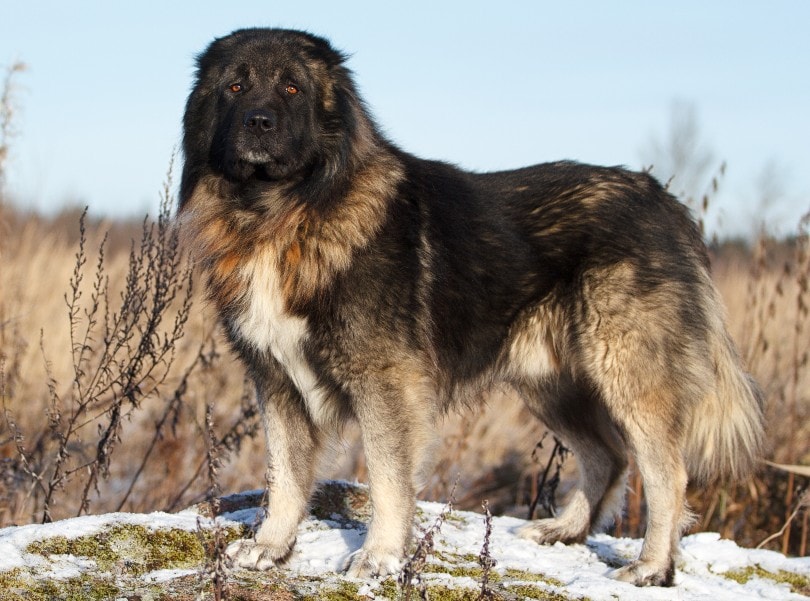
The Caucasian Shepherd descends from dogs of the Caucasus mountain range which spans Armenia, Azerbaijan, Georgia, and Russia. Their ancestors were kept busy guarding property and livestock and even served in the Armenian army sometime around the first century BC. Their development into the Caucasian Shepherd we know today began in the 1920s in the Soviet Union.
Appearance
The Caucasian Shepherd can grow as large as 30 inches tall. They have medium-length double coats that come in various colors and color combinations, including cream, fawn, gray, rust, and grizzle, and brindle, piebald, and white markings are also possible.
Caucasian Shepherds have a strong, heavily boned, and muscular build, and males are distinguished by their larger heads and bigger bodies, while females are smaller and, though large, appear slightly less massive. The facial expression is best described as solemn or serious but alert.
Personality
In general, Caucasian Shepherds are very self-assured, courageous, and have a strong independent streak, but are nevertheless very loyal and loving with family members if properly socialized, and will protect them at any cost.
That said, the Caucasian may be better suited to a home with older children rather than little ones. Small kids may have trouble understanding boundaries, and it’s imperative that the Caucasian Shepherd is treated with respect. Likewise, the Caucasian Shepherd should be socialized from a young age around any children and other pets at home.
Caucasian Shepherds are naturally alert and often wary or at least reserved around strangers due to their protective nature, so take care if you’re inviting people to your house. These characteristics stem from the breed’s background as a guardian dog.
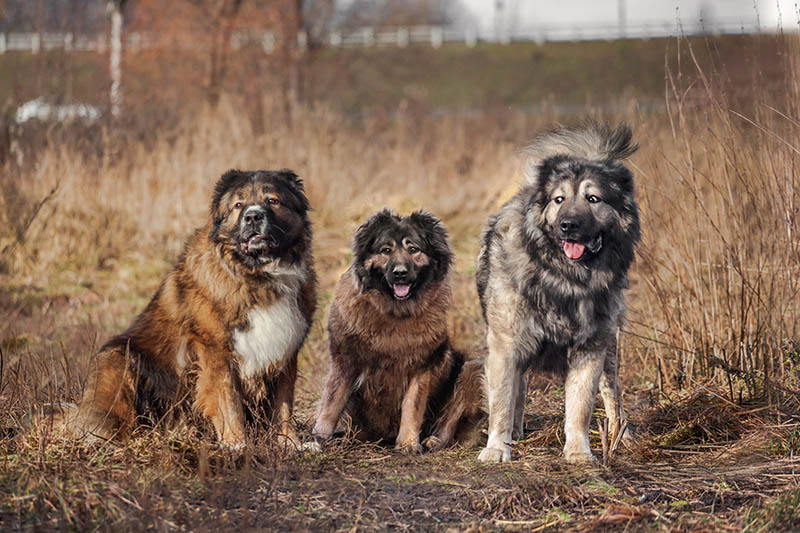
Training
Caucasian Shepherds are not the best dogs for first-time dog parents because their independence and iron will make training rather a challenge at times. It’s best to start training this intelligent dog from an early age with plenty of positive reinforcement, patience, and consistency. Caucasian Shepherds respond best to calm, collected, assured, and firm but kind leaders.
Grooming
If you have a long-coated Caucasian Shepherd, you’ll need to groom them every day to keep the skin and coat healthy. These dogs shed year-round and will “blow” their coats once per year, at which stage you’ll want to employ a de-shedding tool to keep things under control. Their nails also tend to grow quickly, so regular trimming is necessary.
Health & Care
This is quite a healthy breed overall but, as with any breed, it’s important to watch out for changes in your Caucasian Shepherd that could indicate a health problem. Dogs can develop a wide variety of conditions, ranging from minor allergies to life-threatening conditions like heart disease.
One of the health conditions to watch out for in large breeds includes hip and elbow dysplasia, which is a condition that causes loose joints and can cause arthritis down the line. Entropion, which is an inward-growing eyelid, is another condition to be vigilant for in Caucasian Shepherds.
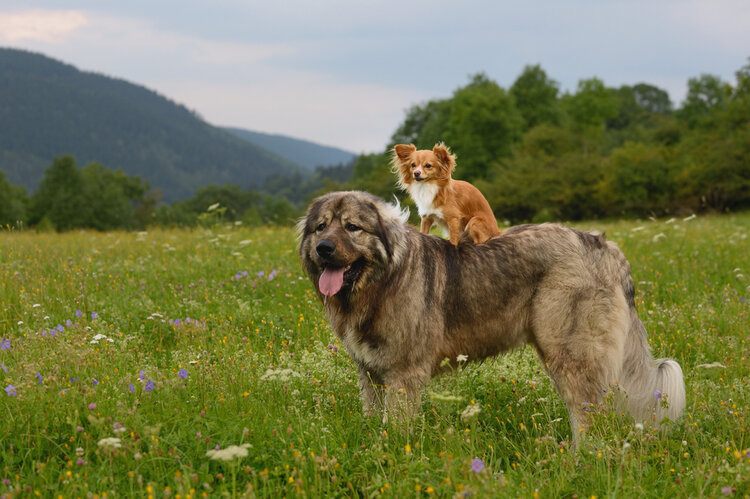
Suitable For:
Caucasian Shepherds are best for people with experience parenting and training dogs—especially large, powerful breeds. The owner must be completely committed to ensuring the Caucasian Shepherd grows up to be a well-mannered, well-adjusted canine citizen, as a lackadaisical approach to training could result in this dog becoming unmanageable.

Tibetan Mastiff Overview

Like the Caucasian Shepherd, the Tibetan Mastiff’s ancestors were ancient guardian dogs, but the Tibetan Mastiff originated in Tibet, where they protected property, flocks, and temples. They were historically given as gifts in Tibet, which shows how highly valued these dogs were. It’s likely that all modern mastiffs or Molosser breeds descend from the Tibetan Mastiff.
Appearance
The Tibetan Mastiff is close in height and weight to the Caucasian Shepherd, but is typically a bit lighter, weighing up to 150 pounds. They also have medium-length double coats, but the colors and color combinations are different. Tibetan Mastiff colors include blue-gray, black, brown, and red gold, and some have white markings.
The Tibetan Mastiff’s head is more lion-like than the Caucasian Shepherd’s, though they are similarly muscular and imposing in appearance. The male Tibetan Mastiff typically has what we might call more of a “mass” of hair than a female. The mass of hair can overpower the eyes, giving them a somewhat droopy appearance.
Personality
The American Kennel Club gives the Tibetan Mastiff 4 out of 5 points on the “affectionate with family” scale, whereas the Caucasian Shepherd received three out of five points. These dogs are considered to be calm and dignified, especially at home, where they are often friendly and affectionate family companions.
Tibetan Mastiffs are famously very reserved around strangers, similar to the Caucasian Shepherd, and are every bit as protective and alert. On the other hand, they’re slightly more playful and energetic than the Caucasian Shepherd Dog in general, but this depends on the individual dog. Canine personalities vary greatly, regardless of generalizations about the breed.
Tibetan Mastiffs can get on well with children and other pets if socialized from a young age, but, like Caucasian Shepherds, they may be a better fit for families with older children.

Training
Tibetan Mastiffs can be very challenging in the training department—even treats don’t typically have much effect—so experienced dog parents are best suited to the job. For one thing, Tibetan Mastiffs are strongly instinct-driven, so tend to go with what their gut tells them over the commands they’ve learned.
Secondly, they quickly learn commands and do well in obedience classes but have a tendency to stop following those commands in the home environment and when out and about. For this reason, it’s best to keep your Tibetan Mastiff on a leash in dog parks and the like because they may not obey you at a crucial moment.
Tibetan Mastiffs have to learn to trust and respect you for training to be a success, so the training process will likely need to focus on building that bond between you and your dog and practicing commands in fun ways to keep their interest. A kind but firm and confident leader is the only match for this headstrong canine.
Grooming
You can typically get away with brushing your Tibetan Mastiff just once weekly but, like Caucasian Shepherds, they blow their coats during shedding season, so you’ll need to be prepared to tackle a lot more hair during this period. They also need to have their nails trimmed regularly to make sure they don’t get too long.
Health & Care
Some of the health conditions that have been linked to Tibetan Mastiffs are similar to those that have been linked to Caucasian Shepherds. As a large breed, they’re susceptible to hip and elbow dysplasia. Entropion (an eye condition) can also affect this breed, as can hypothyroidism. If you spot any changes in your dog, please speak to your vet.
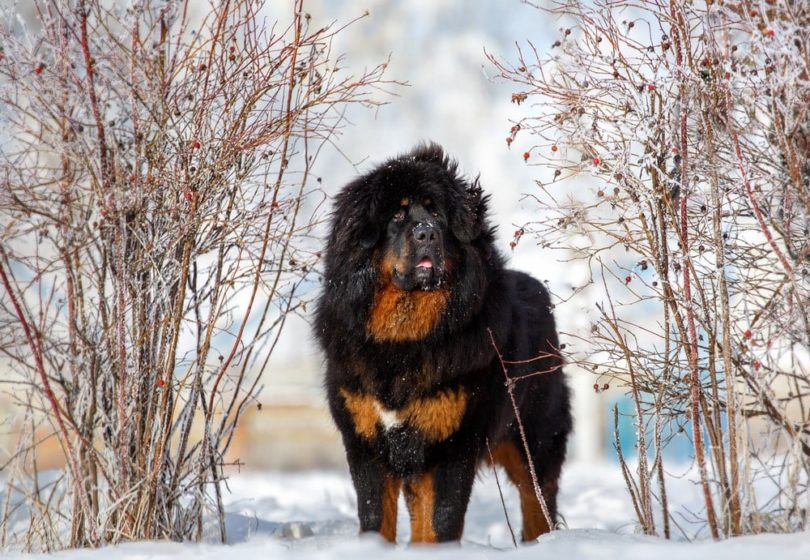
Suitable For:
Tibetan Mastiffs are not for the faint of heart— a lot of confidence is required to properly train and socialize them, especially given their strength, power, and natural distrust of strangers. However, a well-socialized Tibetan Mastiff is a devoted family companion with a lot of love to give, so, if you have the time and can commit fully to one of these canine “lions”, you’re sure to reap plenty of rewards.
Which Breed Is Right for You?
The Caucasian Shepherd and the Tibetan Mastiff are very similar in many ways, and you’re likely to have a similar experience training and socializing them.
In general, Tibetan Mastiffs might be slightly more family-oriented, while Caucasian Shepherds might respond better to more traditional, treat-based training, but there is no guarantee as these are just generalizations. You should always meet the dog and get to know them to help you make your decision—let this be what guides you instead of deciding based purely on the dog’s breed.
Featured Image Credit: (T) Aleksandra Saveljeva, Shutterstock | (B) Svetography, Shutterstock

